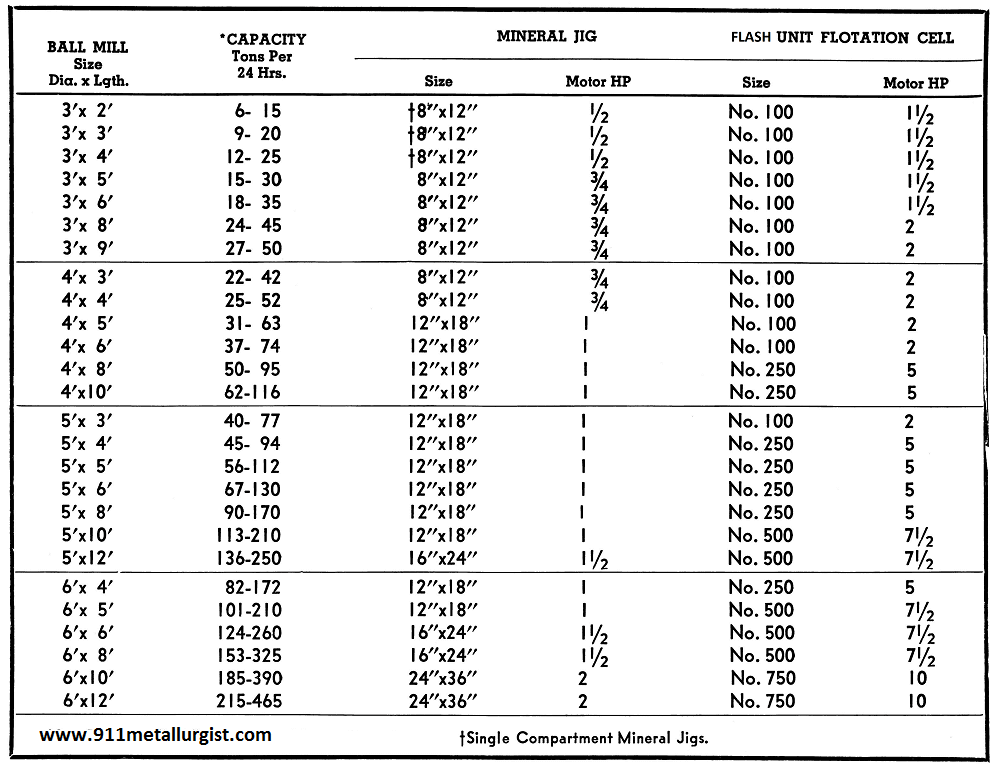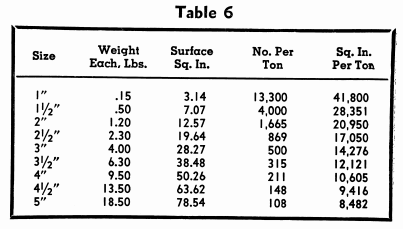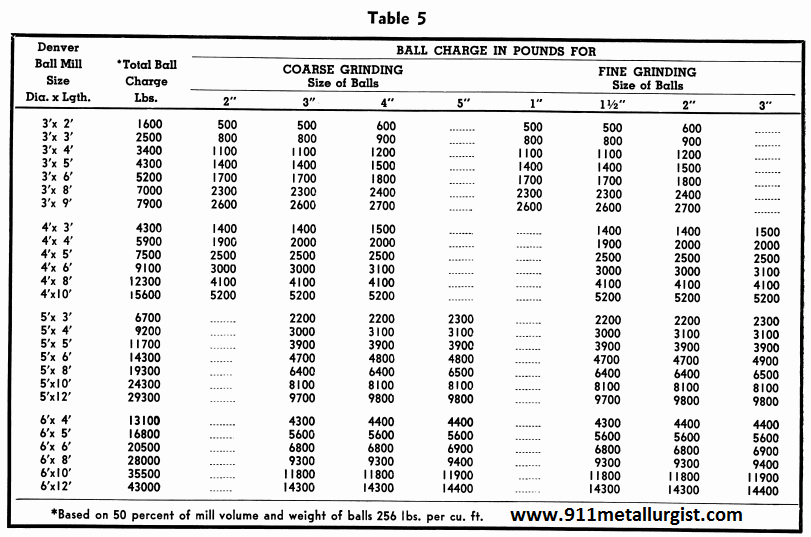In all ore dressing and milling processes, including flotation, cyanidation, gravity concentration, and amalgamation, it is necessary to crush and grind, often with rob mill & ball mills, the ore in order to liberate the minerals. In the chemical and process industries, grinding is an important step in preparing raw materials for subsequent treatment. In present day practice, ore is reduced to a size many times finer than can be obtained with crushers. Over a period of many years various fine grinding machines have been developed and used, but the ball mill has become standard due to its simplicity and low operating cost.
GRINDING MILLS
Ball mills efficiently perform a wide variety of services. In small milling plants, where simplicity is most essential, it is not economical to use more than single stage crushing, because the Steel-Head Ball or Rod Mill will take up to 2″ feed and grind it to the desired fineness. In larger plants where several stages of coarse and fine crushing are used, it is customary to crush from 1/2″ to as fine as 8 mesh.
Many grinding circuits necessitate regrinding of concentrates or middling products to extremely fine sizes to liberate the closely associated minerals from each other. In these cases, the feed to the ball mill may be from 10 to 100 mesh or even finer.
Where the finished product does not have to be uniform, a ball mill may be operated in open circuit, but where the finished product must be uniform it is essential that the grinding mill be used in closed circuit with a screen, if a coarse product is desired, and with a classifier if a fine product is required. In most cases it is desirable to operate the grinding mill in closed circuit with a screen or classifier as higher efficiency and capacity are obtained. Often a mill using steel rods as the grinding medium is recommended, where the product must have the minimum amount of fines (rods give a more nearly uniform product).
Often a problem requires some study to determine the economic fineness to which a product can or should be ground. In this case the 911Equipment Company offers its complete testing service so that accurate grinding mill size may be determined.
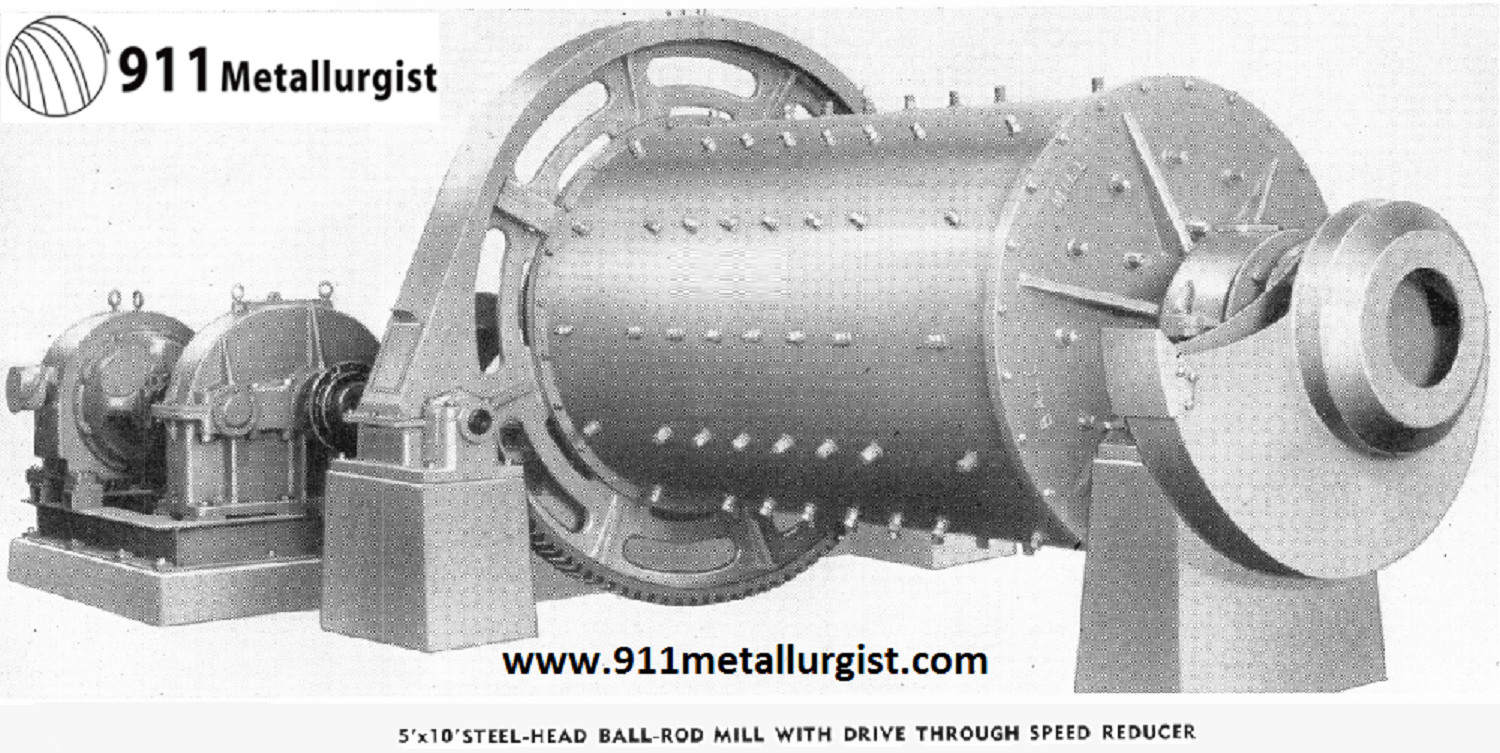
Ball Mill Capacity VS Rod Mill Capacity
Until recently many operators have believed that one particular type of grinding mill had greater efficiency and resulting capacity than some other type. However, it is now commonly agreed and accepted that the work done by any ball mill depends directly upon the power input; the maximum power input into any ball or rod mill depends upon weight of grinding charge, mill speed, and liner design.
The apparent difference in capacities between grinding mills (listed as being the same size) is due to the fact that there is no uniform method of designating the size of a mill, for example: a 5′ x 5′ Ball Mill has a working diameter of 5′ inside the liners and has 20 per cent more capacity than all other ball mills designated as 5′ x 5′ where the shell is 5′ inside diameter and the working diameter is only 4’8″ with the liners in place.
Ball-Rod Mills, based on 4″ liners and capacity varying as 2.6 power of mill diameter, on the 5′ size give 20 per cent increased capacity; on the 4′ size, 25 per cent; and on the 3′ size, 28 per cent. This fact should be carefully kept in mind when determining the capacity of a Steel- Head Ball-Rod Mill, as this unit can carry a greater ball or rod charge and has potentially higher capacity in a given size when the full ball or rod charge is carried.
A mill shorter in length may be used if the grinding problem indicates a definite power input. This allows the alternative of greater capacity at a later date or a considerable saving in first cost with a shorter mill, if reserve capacity is not desired.
The capacities of Ball-Rod Mills are considerably higher than many other types because the diameters are measured inside the liners.
In Table I capacities have been calculated according to the conditions specified.
A grate discharge may give beneficial results on certain ores especially where an excess of fine sizes is detrimental.
Rod Mill Capacity Table
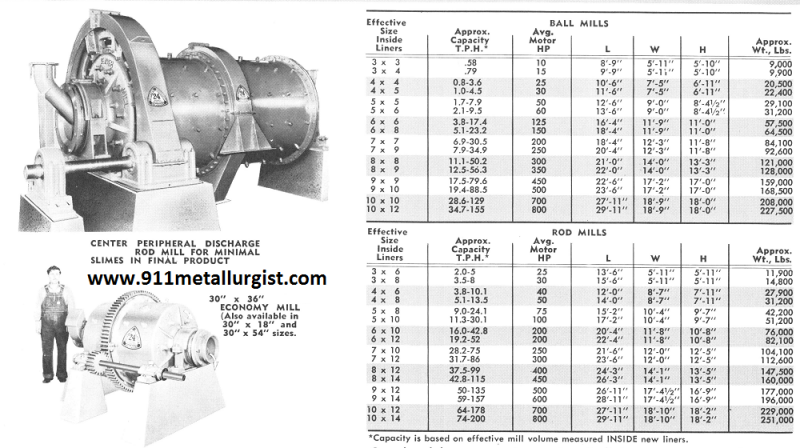
Small Ball Mill Capacity and Sizing
Ball VS Rob Mill Conversion
The correct grinding mill depends so much upon the particular ore being treated and the product desired, that a mill must have maximum flexibility in length, type of grinding medium, type of discharge, and speed. With the Ball-Rod Mill it is possible to build this unit in exact accordance with your requirements, as illustrated.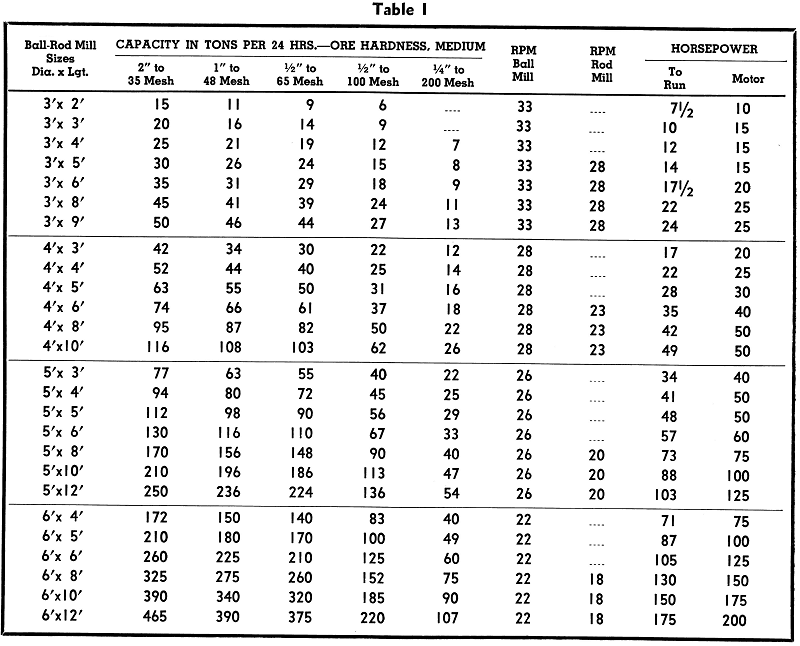
Types of Mill Discharge
Steel-Head Ball-Rod Mills are available in any one of five different types of discharge:
- Overflow,
- perforated overflow,
- return spiral,
- grate, and
- peripheral.
To best serve your needs, the Trunnion can be furnished with small (standard), medium, or large diameter opening for each type of discharge. The sketch shows diagrammatic arrangements of the four different types of discharge for each size of trunnion opening, and peripheral discharge is described later.
Ball Mill Trunnion and Mill Grate Discharge
The overflow type is more commonly used as it is lower in first cost. These mills have large trunnion openings which allow high circulating loads to be carried if desired.
Any overflow type mill can be easily converted to a grate discharge type by merely adding the improved grate head liners and the proper shell liners, or vice versa.
Ball-Rod Mills of the grate discharge type are made by adding the improved type of grates to a standard Ball-Rod Mill. These grates are bolted to the discharge head in much the same manner as the standard headliners.
The grates are of alloy steel and are cast integral with the lifter bars which are essential to the efficient operation of this type of ball or rod mill. These lifter bars have a similar action to a pump: i. e., in lifting the product so as to discharge quickly through the mill trunnion.
These Discharge Grates also incorporate as an integral part, a liner between the lifters and steel head of the ball mill to prevent wear of the mill head. By combining these parts into a single casting, repairs and maintenance are greatly simplified. The center of the grate discharge end of this mill is open to permit adding of balls or for adding water to the mill through the discharge end.
Instead of being constructed of bars cast into a frame, Grates are cast entire and have cored holes which widen toward the outside of the mill similar to the taper in grizzly bars. The grate type discharge is illustrated.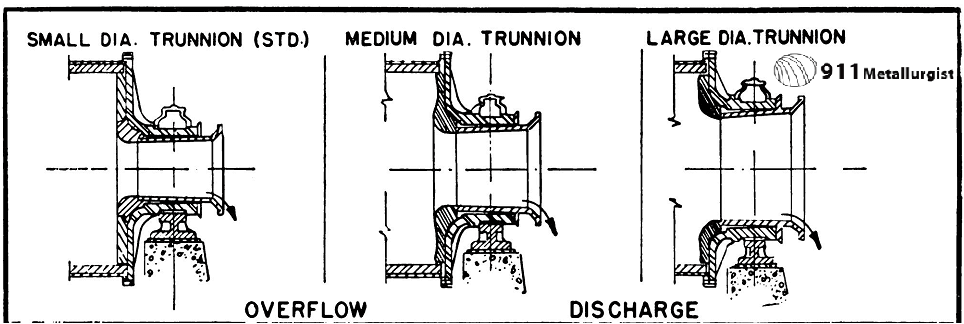



Peripheral Grinding Mill Discharge
The peripheral discharge type of Ball-Rod Mill is a modification of the grate type, and is recommended where a free gravity discharge is desired. It is particularly applicable when production of too many fine particles is detrimental and a quick pass through the mill is desired, and for dry grinding.
The drawings show the arrangement of the peripheral discharge. The discharge consists of openings in the shell into which bushings with holes of the desired size are inserted. On the outside of the mill, flanges are used to attach a stationary discharge hopper to prevent pulp splash or too much dust.
The mill may be operated either as a peripheral discharge or a combination or peripheral and trunnion discharge unit, depending on the desired operating conditions. If at any time the peripheral discharge is undesirable, plugs inserted into the bushings will convert the mill to a trunnion discharge type mill.
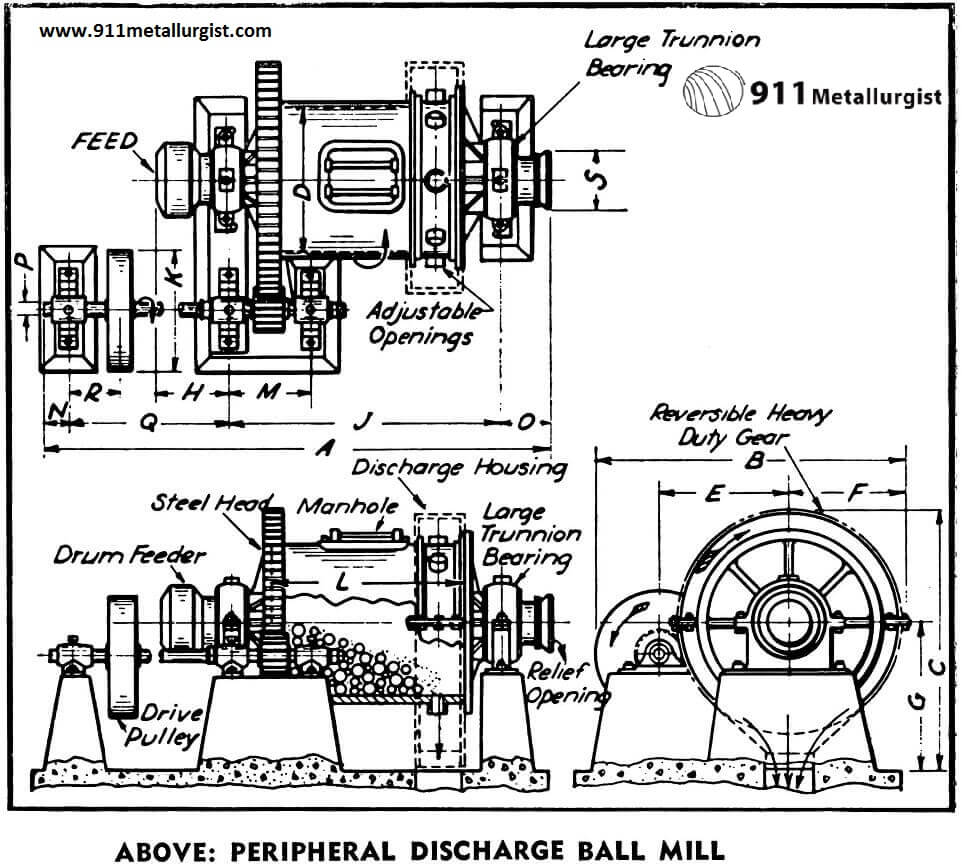
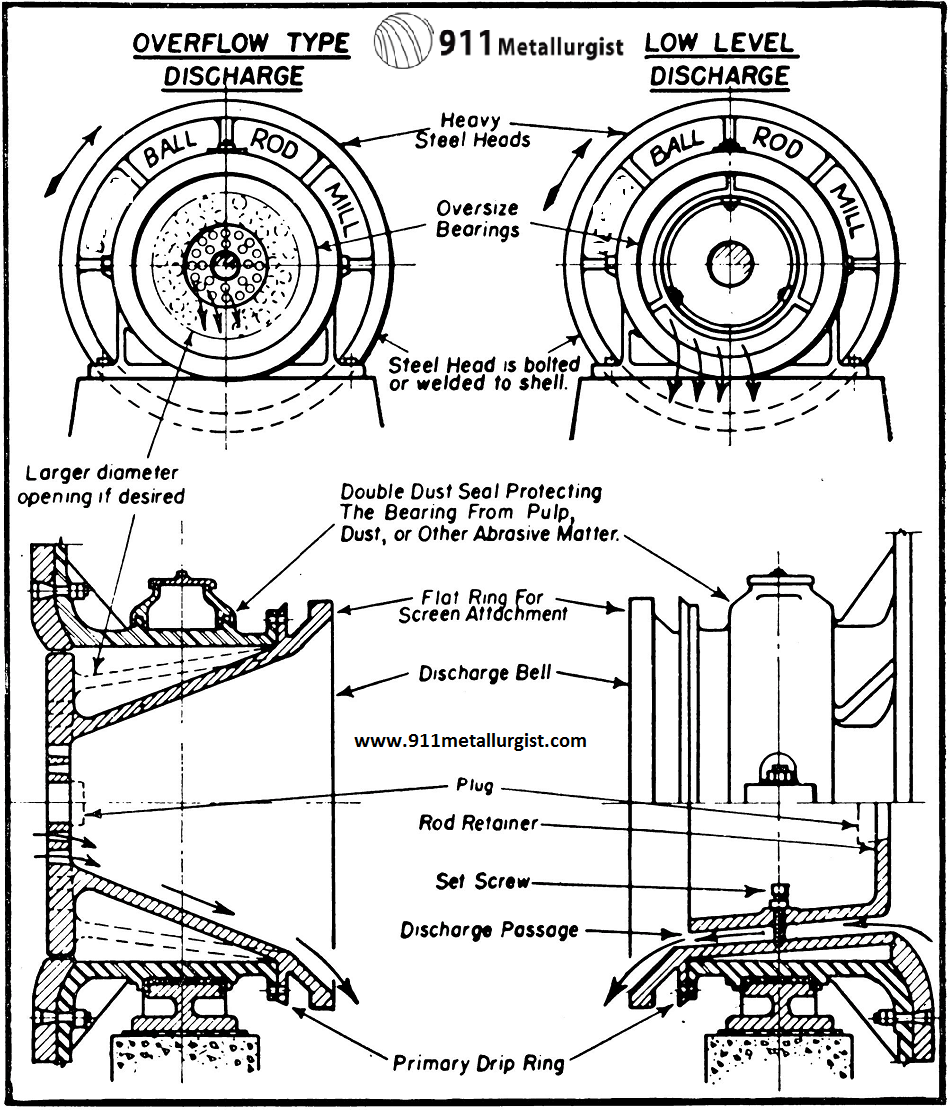
Load Capacity of Trunnion Bearings
are made to support a mill with a length double its diameter





Ball Mill & Rod Mill Liners
The head and shell liners for Ball-Rod Mills can be furnished of:
- Decolloy,
- Hard White Iron,
- Electric Steel,
- Chrome-Moly Steel,
- Manganese Steel.
These liners are all of ample thickness to give long life and uniform wear, yet, when new, they do not unduly decrease the capacity of the ball mill.
What is Decolloy? Decolloy is one of the hardest and toughest white cast iron compositions commercially available. It is essentially a high carbon base chrome and nickel iron.
Unless otherwise specified, a hard iron liner is furnished. This liner is made of the best grade white iron and is most serviceable for the smaller size mills where large balls are not used. Hard iron liners have a much lower first cost.
Electric steel, although more expensive than hard iron, has advantage of minimum breakage and allows final wear to thinner section. Steel liners are recommended when the mills are for export or where the source of liner replacement is at a considerable distance.
Molychrome steel has longer wearing qualities and greater strength than hard iron. Breakage is not so apt to occur during shipment, and any size ball can be charged into a mill equipped with molychrome liners.
Manganese liners for Ball-Rod Mills are the world famous AMSCO Brand, and are the best obtainable. The first cost is the highest, but in most cases the cost per ton of ore ground is the lowest. These liners contain 12 to 14% manganese.
The feed and discharge trunnions are provided with cast iron or white iron throat liners. As these parts are not subjected to impact and must only withstand abrasion, alloys are not commonly used but can be supplied.
Liners for any size mill are of such dimensions and weight that they will pass through the manhole without difficulty.
Grinding Mill Gears
Gears for Ball-Rod Mills drives are furnished as standard on the discharge end of the mill where they are out of the way of the classifier return, scoop feeder, or original feed. Due to convertible type construction the mills can be furnished with gears on the feed end. Gear drives are available in two alternative combinations, which are:
- Cast Tooth Spur Gear and Pinion. These gears are made of high grade cast iron with cast teeth which are made from a full pattern and not a sweep pattern. This insures round gears which run true and accurately. The pinion is made of cast electric steel with correctly formed teeth; cut steel pinion can be supplied.
- Cut Tooth Spur Gear and Pinion. The gear is made of high grade cast iron with teeth accurately machine cut from the blank; the pinion is a steel forging with precision machine cut teeth.
The gears are provided with a substantial web centrally placed, machined on both faces and drilled to template so that if the gear is worn on one side, it can be reversed, as both sides are machined.
All pinions are properly bored, key-seated, and pressed onto the steel countershaft, which is oversize and properly keyseated for the pinion and drive pulleys or sheaves. The countershaft operates on high grade, heavy duty, nickel babbitt bearings.
The three point bearing pinion shaft insures perfect alignment, and longer, more dependable life. Shaft and bearings are heavy and of ample size; bearings are hooded to exclude dirt.
The bearings are mounted on heavy sole plates which give perfect alignment. These sole plates are provided with take-ups for easy and quick adjustment.
Grinding Mill Drives
Any type of drive can be furnished for Ball-Rod Mills in accordance with your requirements. Belt drives are available with pulleys either plain or equipped with friction clutch. Various V- Rope combinations can also be supplied.
When a motor drive is selected, please mention which drive arrangement is to be used.
The most economical drive to use up to 50 H. P., is a high starting torque motor connected to the pinion shaft by means of a flat or V-Rope drive. For larger size motors the wound rotor (slip ring) is recommended due to its low current requirement in starting up the ball mill.
Should you be operating your own power plant or have D. C. current, please specify so that there will be no confusion as to motor characteristics. If switches are to be supplied, exact voltage to be used should be given.
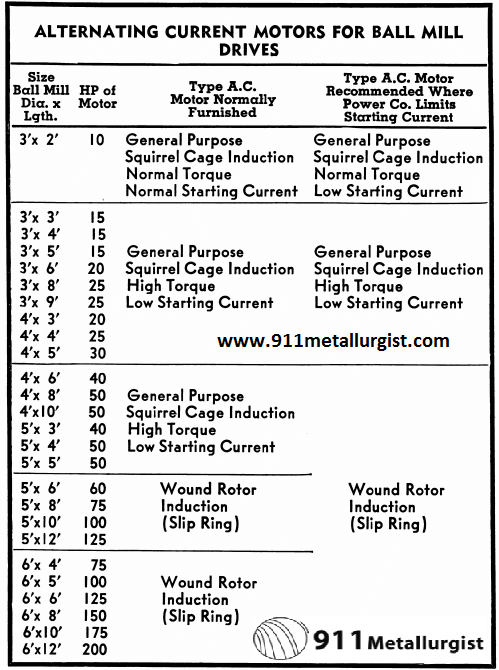
Ball Mill Grinding Circuit
Even though many ores require fine grinding for maximum recovery, most ores liberate a large percentage of the minerals during the first pass through the grinding unit. Thus, if the free minerals can be immediately removed from the ball mill classifier circuit, there is little chance for overgrinding.
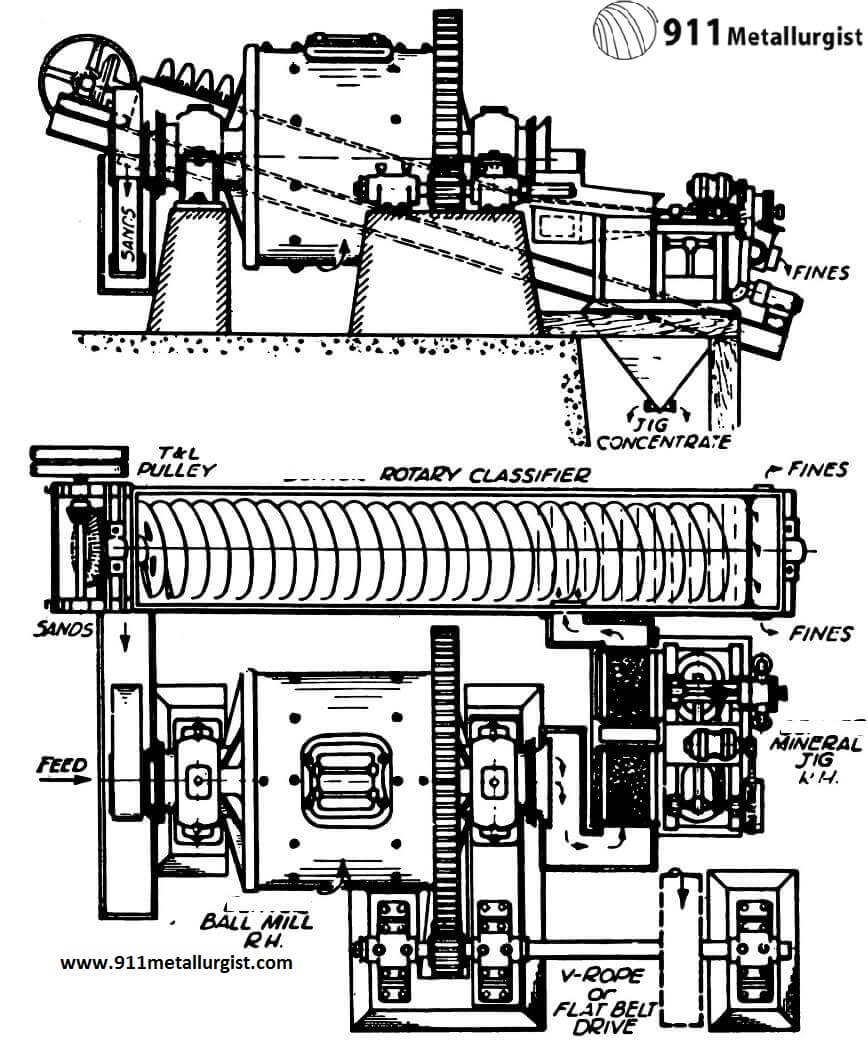
This is actually what has happened wherever Mineral Jigs or Unit Flotation Cells have been installed in the ball mill classifier circuit. With the installation of one or both of these machines between the ball mill and classifier, as high as 70 per cent of the free gold and sulphide minerals can be immediately removed, thus reducing grinding costs and improving over-all recovery.
The advantage of this method lies in the fact that heavy and usually valuable minerals, which otherwise would be ground finer because of their faster settling in the classifier and consequent return to the grinding mill, are removed from the circuit as soon as freed. This applies particularly to gold and lead ores.
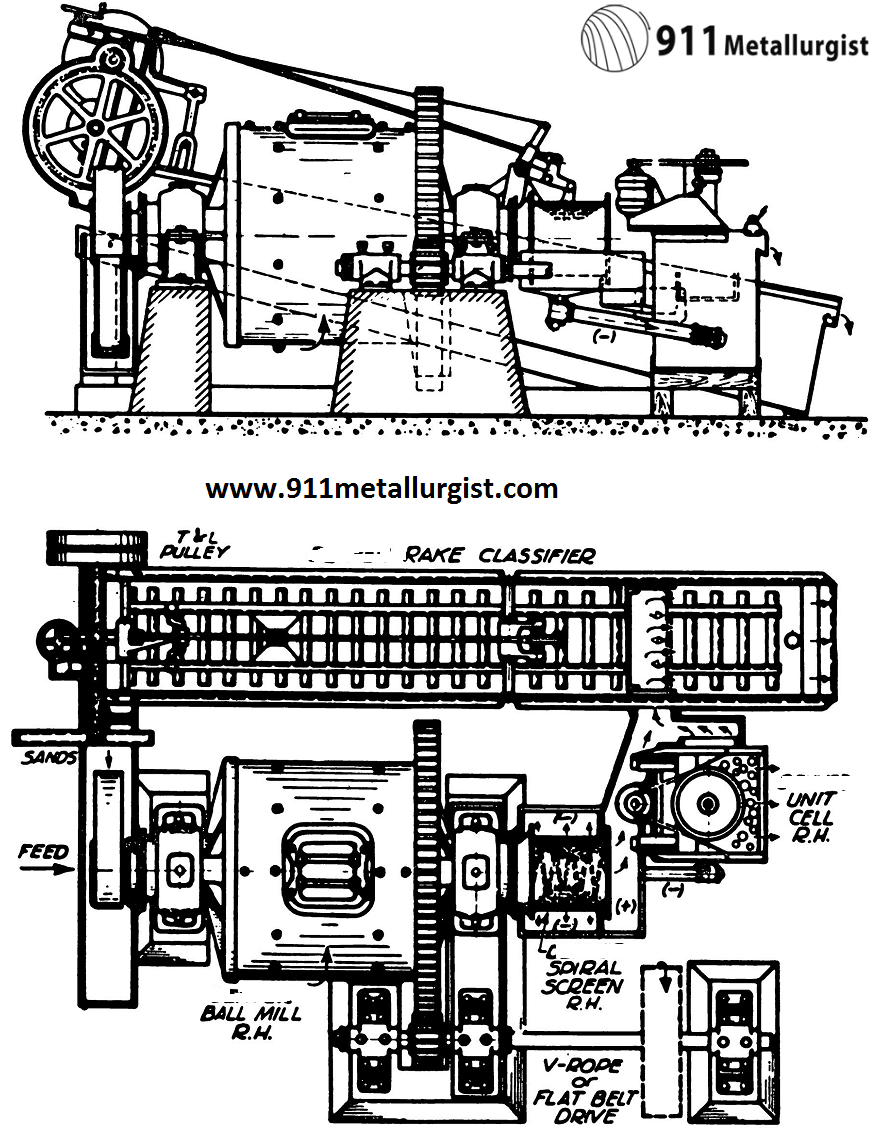
The Mineral Jig is a high speed fine mineral recovery unit and is distinctive in that it does not dilute the circuit; minimum water is used due to synchronization of the valve with plunger stroke.
The “Sub-A” Unit Flotation Cell has the exclusive gravity flow principle of circulating coarse material, which has made it possible to use flotation of a ball mill discharge without chokeups.
Grinding Mill Specifications
All-Steel Shells and Heads
Ball-Rod Mills have heavy rolled steel plate shells which are arc welded inside and outside to the steel heads or to rolled steel flanges, depending upon the type of mill. The double welding not only gives increased structural strength, but eliminates any possibility of leakage.
Where a single or double flanged shell is used, the faces are accurately machined and drilled to template to insure perfect fit and alignment with the holes in the head. These flanges are machined with male and female joints which take the shearing stresses off the bolts.
The Ball-Rod Mill Heads are oversize in section, heavily ribbed and are cast from electric furnace steel which has a strength of approximately four times that of cast iron. The head and trunnion bearings are designed to support a mill with length double its diameter. This extra strength, besides eliminating the possibility of head breakage or other structural failure (either while in transit or while in service), imparts to Ball-Rod Mills a flexibility heretofore lacking in grinding mills. Also, for instance, if you have a 5′ x 5′ mill, you can add another 5′ shell length and thus get double the original capacity; or any length required up to a maximum of 12′ total length.
On Type “A” mills the steel heads are double welded to the rolled steel shell. On type “B” and other flanged type mills the heads are machined with male and female joints to match the shell flanges, thus taking the shearing stresses from the heavy machine bolts which connect the shell flanges to the heads.
The manhole cover is protected from wear by heavy liners. An extended lip is provided for loosening the door with a crow-bar, and lifting handles are also provided. The manhole door is furnished with suitable gaskets to prevent leakage.
Trunnion Bearings of Grinding Mill
The trunnions are an integral part of the steel heads and are turned true with the axis of the mill. After machining, the trunnions are given a polished surface to minimize friction.
The mill trunnions are carried on heavy babbitt bearings which provide ample surface to insure low bearing pressure. If at any time the normal length is doubled to obtain increased capacity, these large trunnion bearings will easily support the additional load.
Trunnion bearings are of the rigid type, as the perfect alignment of the trunnion surface on Ball-Rod Mills eliminates any need for the more expensive self-aligning type of bearing.
The highest grade nickel babbitt obtainable is used in the trunnion bearings and pinion shaft bearings.
The cap on the upper half of the trunnion bearing is provided with a shroud which extends over the drip flange of the trunnion and effectively prevents the entrance of dirt or grit. The bearing has a large space for wool waste and lubricant and this is easily accessible through a large opening which is covered to prevent dirt from getting into the bearing. Ball and socket bearings can be furnished.
Types of Mill Feed Chute
Scoop Feeders for Ball-Rod Mills are made in various radius sizes. Standard scoops are made of cast iron and for the 3′ size a 13″ or 19″ feeder is supplied, for the 4′ size a 30″ or 36″, for the 5′ a 36″ or 42″, and for the 6′ a 42″ or 48″ feeder. Welded steel scoop feeders can, however, be supplied in any radius.
The correct size of feeder depends upon the size of the classifier, and the smallest feeder should be used which will permit gravity flow for closed circuit grinding between classifier and the ball or rod mill. All feeders are built with a removable wearing lip which can be easily replaced and are designed to give minimum scoop wear.
A combination drum and scoop feeder can be supplied if necessary. This feeder is made of heavy steel plate and strongly welded. These drum-scoop feeders are available in the same sizes as the cast iron feeders but can be built in any radius. Scoop liners can be furnished.
The trunnions on Ball-Rod Mills are flanged and carefully machined so that scoops are held in place by large machine bolts and not cap screws or stud bolts. The feed trunnion flange is machined with a shoulder for insuring a proper fit for the feed scoop, and the weight of the scoop is carried on this shoulder so that all strain is removed from the bolts which hold the scoop.
Steel Head Ball Mills
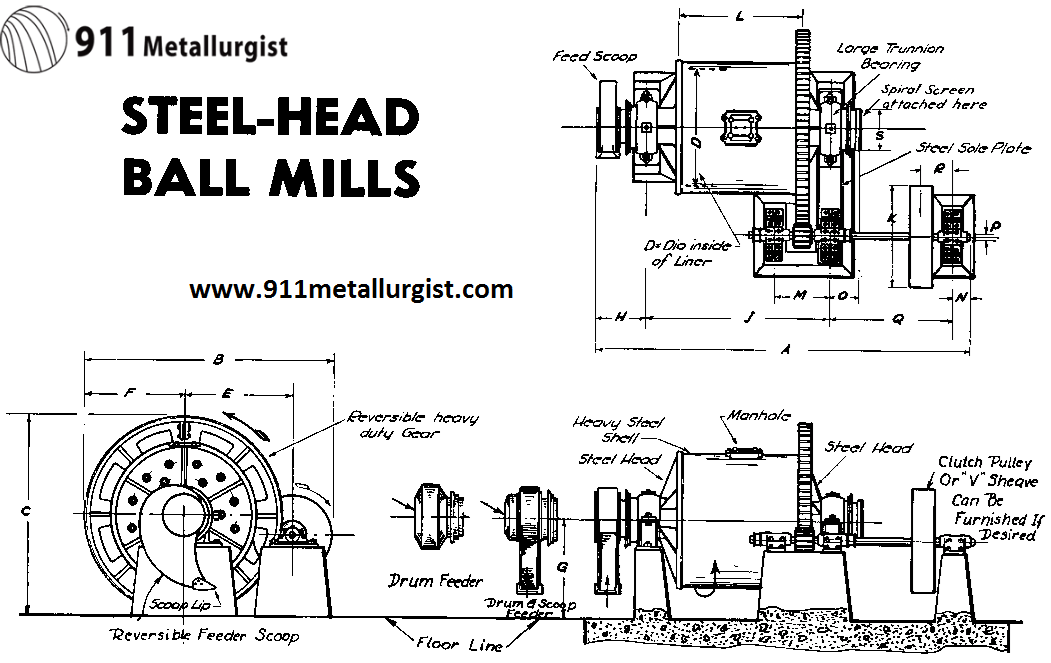
Steel-Head Rod Mills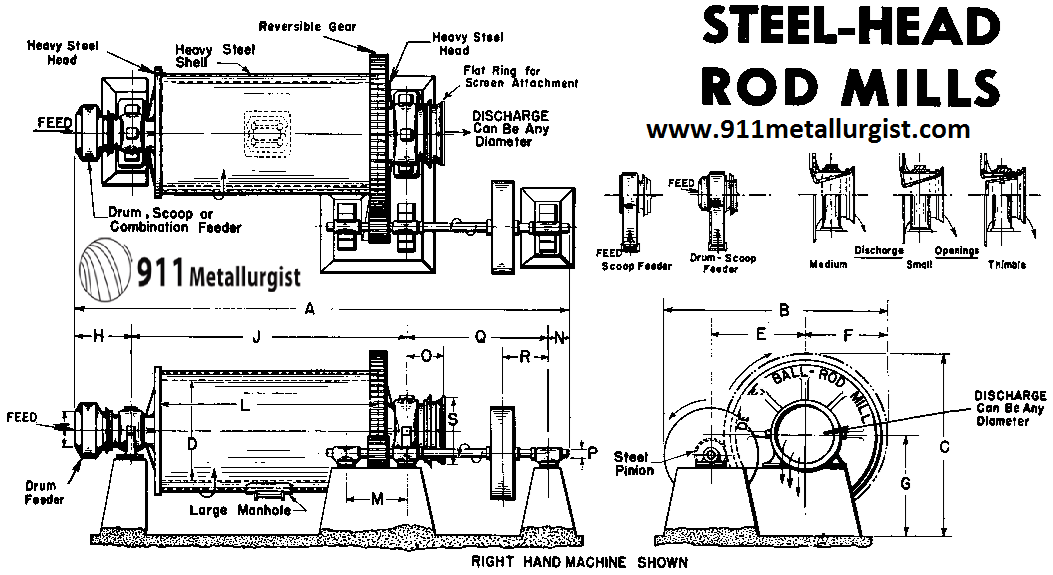

Quotation on a Ball Mill Price or a Rod Mill Price
When requesting a quotation on a Ball- Rod Mill, it is requested that you include the following information:
- Type of mill: Type “A” is standard, except 3′ x 2′ which is Type “B” without manhole.
- Discharge, whether overflow, perforated over-flow, return spiral, grate or peripheral discharge. The size of trunnion opening desired should be specified. Unless specified, the small diameter trunnion overflow type will be furnished.
- Liners—hard iron liners are standard and will be furnished unless otherwise specified.
- Gears—whether cast tooth spur gear and pinion (standard) or cut tooth spur gear and pinion.
- Drive—belt or motor. Belt drive without pulley is standard. If motor drive, specify type of motor and also type of drive arrangement.
- Feeders—cast iron scoop feeder with removeable wearing lip of alloy steel is standard; welded steel scoop can be supplied if desired. Drum-scoop feeder made of welded steel, is available. Specify size desired.
- When ordering, include a small sketch of your ball mill classifier layout. Right hand mill is standard. This should show the ball mill (feed, discharge and position of drive); Unit Flotation Cell or a Mineral Jig, if in circuit, and classifier.
Grinding Rods
High carbon steel rods are recommended, hot rolled, hot sawed or sheared, to a length of 2″ less than actual length of mill taken inside the liners.
The initial rod charge is generally a mixture ranging from 1.5″ to 3″ in diameter. During operation, rod make-up is generally the maximum size. The weights per lineal foot of rods of various diameters are approximately: 1.5″ to 6 lbs.; 2″-10.7 lbs.; 2.5″-16.7 lbs.; and 3″-24 lbs.
Grinding Balls
Forged from the best high carbon manganese steel, they are of the finest quality which can be produced and give long, satisfactory service.
Data on ball charges for Ball-Rod Mills are listed in Table 5. Further information regarding grinding balls is included in Table 6.
What is the Steel Charge of a Ball Mill
Difference Between a Rod Mill and Ball Mill
Rod Mills has a very define and narrow discharge product size range. Feeding a Rod Mill finer rocks will greatly impact its tonnage while not significantly affect its discharge product sizes. The 3.5” diameter rod of a mill, can only grind so fine.
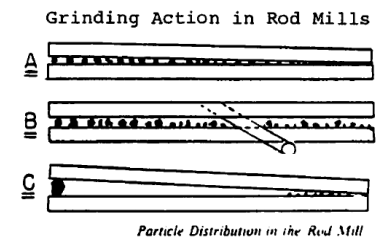 |
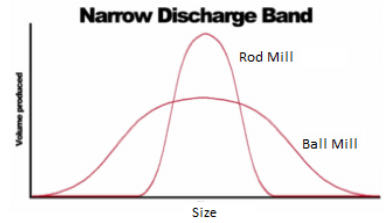 |
Crushers are well understood by most. Rod and Ball Mills not so much however as their size reduction actions are hidden in the tube (mill). As for Rod Mills, the image above best expresses what is going on inside. As rocks is feed into the mill, they are crushed (pinched) by the weight of its 3.5” x 16’ rods at one end while the smaller particles migrate towards the discharge end and get slightly abraded (as in a Ball Mill) on the way there.
How much steel enters a ball mill
Source: This article is a reproduction of an excerpt of “In the Public Domain” documents held in 911Metallurgy Corp’s private library.

